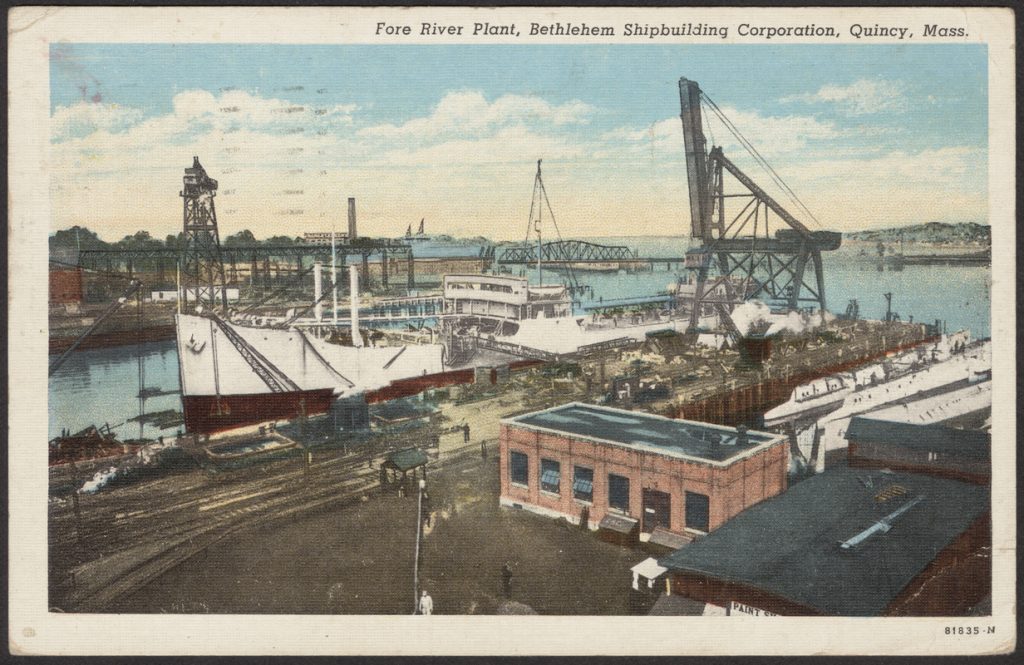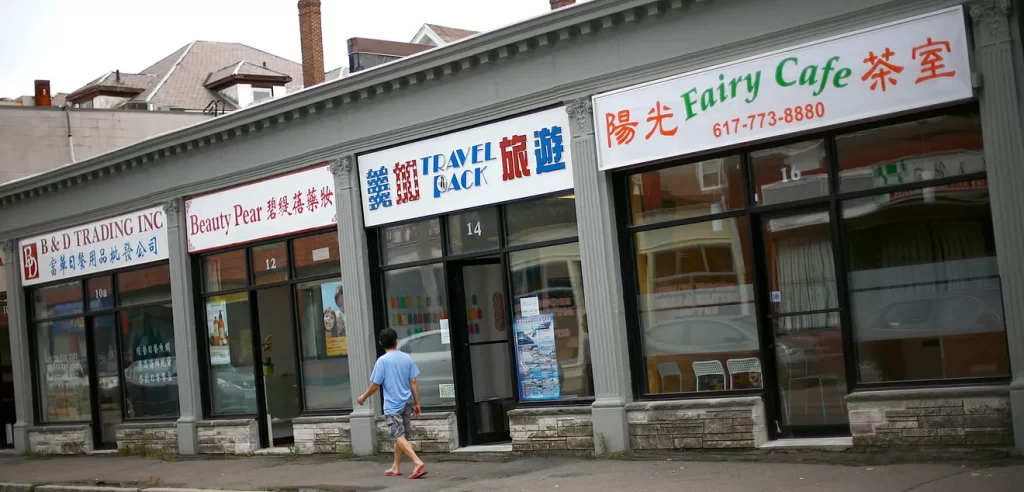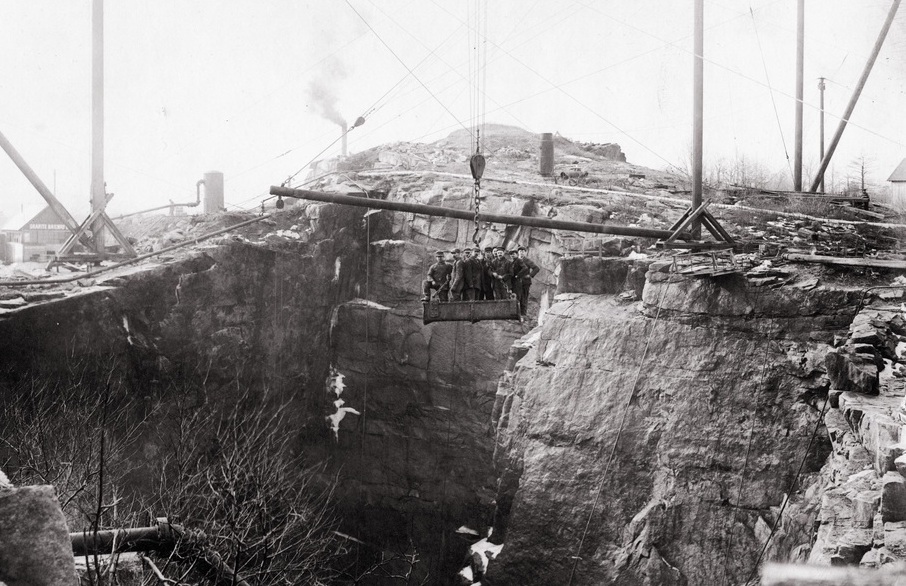From the 1820s until the mid-20th century, thousands of skilled immigrant stonecutters found jobs in Quincy’s granite industry. Shown here are quarrymen coming up in a “boat” for dinner in the Granite Railway Quarry, ca. 1920-1930. Courtesy Thomas Crane Public Library, Quincy.
Part of the homelands of the Neponset band of the Massachusett people, Quincy became a town in 1792 and became well known as the birthplace of presidents John Adams and John Quincy Adams and first lady Abigail Adams. The community had a long history of industrial development and immigrant settlement. Quincy’s rural beginnings were first transformed in the nineteenth century by a booming granite industry that attracted thousands of skilled Irish, Scottish, Finnish, Swedish, and Italian quarrymen and stonecutters. Ethnic-based settlements sprouted up in west and south Quincy adjacent to the quarries, of which there were more than fifty between 1825 and 1963. Immigrant workers there produced high quality granite used to build impressive buildings and monuments across the country.

Owned by the Bethlehem Shipbuilding Corporation, the Fore River Shipyard (shown here ca. 1940) employed generations of immigrant shipbuilders in Quincy. Courtesy Thomas Crane Public Library, Quincy.
Quincy also developed an important shipbuilding industry that built sloops and schooners for the granite trade. In 1900, local shipbuilders founded the Fore River shipyards in Quincy Point to produce steel ships for the Navy. Bethlehem Steel purchased the yards in 1913, and Fore River became one of nation’s busiest shipbuilding centers during World War I. An even bigger boom accompanied World War II, when Bethlehem employed roughly forty thousand workers to build destroyers, cruisers, and aircraft carriers. The yards attracted thousands of new workers to Quincy, including many women and immigrants from Greece, Syria, and Canada. Many lived in Quincy Point, a working-class neighborhood just west of the Fore River yards. This area became home to Boston’s first sizeable Muslim community and New England’s first mosque, built in 1964.
After World War II, the granite and shipbuilding industries began to contract. The last quarry closed in 1964, though shipbuilding continued at reduced levels until the yards closed in 1986. The city thus lost population for the first time, falling from a peak of 91,487 in 1975 to 84,944 in 1980. At the same time, however, the Massachusetts Bay Transit Authority had expanded Red Line service into Quincy, with stops in Wollaston, North Quincy, and Quincy Center. Hoping to attract new residents, the city issued building permits for thousands of new homes and apartments, expanding the housing stock by more than seven thousand units between 1960 and 1980.
In the 1980s, the population began to grow again as Asian immigrants discovered the city. By this time, the pressures of urban redevelopment in Boston’s Chinatown had become intense and the neighborhood overcrowded. A survey of Quincy conducted in 1988 showed that many of Quincy’s newcomers—mainly from Hong Kong, Taiwan, and Guangzhou—had initially settled in Chinatown. Quincy’s abundant stock of rental properties attracted a small stream of these migrants in the late 1970s, many of whom later purchased homes in the North Quincy and Wollaston areas. Some were restaurant or garment workers who pooled their incomes to buy homes for the first time.
Quincy also attracted a growing number of Vietnamese refugees, many of whom were sponsored or assisted by the Wollaston Lutheran church, which began outreach to the local Asian community in the mid-1980s. The church hired a Chinese and Vietnamese-speaking pastor in 1988, and it provided English classes, job placement, and other services for migrants. Soon these families were sponsoring relatives who came directly from China and Southeast Asia.

By the 1990s, Asian-owned businesses were prevalent in the commercial districts of North Quincy and Wollaston, rivaling Boston’s Chinatown. This view of Brook Street in 2013 courtesy of the Patriot Ledger.
Affordable housing, accessible mass transit, and immigrant services helped push Quincy’s Asian American population from 330 in 1980, to 5,577 in 1990, to 21,463 (or 23 percent of the city’s population) in 2020. This burgeoning community supported a growing number of Asian-owned restaurants, stores, and services that sprang up along Hancock street in north Quincy and Wollaston. Asian cultural and social service programs were also established, some of them satellite offices of Chinatown organizations. By 2000, in fact, Quincy’s Asian American population was more than three times larger than that of Boston’s Chinatown.
Other newcomers also contributed to Quincy’s growing diversity. Irish immigrants flocked there in the 1980s, Indians began arriving in the 1990s, and Albanians formed a sizeable community starting in the 2010s. Integrating these newcomers was not always a smooth process. In the 1980s, the city experienced significant racial tensions and violence directed toward Southeast Asian and Chinese residents. The city gradually increased its outreach to these communities, providing English classes and various multilingual services. It also worked with groups like Quincy Asian Resources, Inc. to develop multicultural programming to showcase immigrant cultures and help familiarize the larger community with its new neighbors. But tensions over immigration have periodically emerged since, such as heated conflicts over whether Quincy would become a sanctuary city (the proposal was voted down in 2017) and in response to the opening of a state-funded Family Welcome Center in 2023 to provide temporary shelter for newly arrived immigrants. But despite these tensions, much of the Quincy community has welcomed their foreign-born neighbors, who in 2020 made up roughly a third of the city’s population.
–Marilynn Johnson
Works Cited
Bock, Paula and Ken Brusic. The Asians: Quincy’s Newest Immigrants. Quincy, MA: Patriot Ledger, August 7, 1985.
Holley, H. Hobart. Quincy’s Legacy. Quincy, MA: Quincy Historical Society, 1998.
Johnson, Marilynn S. The New Bostonians. Boston: University of Massachusetts Press, 2015.
Lahaj, Mary. “Building an Islamic Community in America: History of the Islamic Center of New England.” M.A. thesis, Hartford Seminary, 1992.
Quincy Quarry and Granite Workers Museum, Quincy, MA.
Ramos, Jill Terreri. “Quincy Rejects Proposed ‘Sanctuary City’ Study,” Boston Globe, March 8, 2017.
Reid, Alexander. “Asian Influx Forging a New Community in Historic Quincy,” Boston Globe, March 8. 1998.
Scott, Ivy. “Residents Clash over Migrant Shelter at Quincy Community Meeting,” Boston Globe, September 13, 2023.


